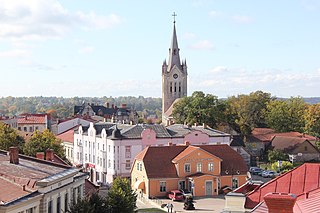
Cēsis, is a town in Latvia located in the northern part of the Central Vidzeme Upland. Cēsis is on the Gauja River valley, and is built on a series of ridges above the river overlooking the woods below. Cēsis was one of the candidate cities for the title of European Capital of Culture 2014.
Koknese is a town in Aizkraukle Municipality in the Vidzeme region of Latvia, on the right bank of the Daugava River. It has a population of nearly 3,000.

Aizkraukle is a town in Vidzeme region in Latvia, the administrative centre of Aizkraukle Municipality on the right bank of the Daugava River. The population in 2020 was 7,018.
Viestards was one of the greatest Semigallian dukes in the 13th century, referred to as King Vester.

The Livonian crusade refers to the various military Christianisation campaigns in medieval Livonia – in what is now Latvia and Estonia – during the Papal-sanctioned Northern Crusades in the 12–13th century. The Livonian crusade was conducted mostly by the Holy Roman Empire and the Kingdom of Denmark. It ended with the creation of Terra Mariana and the Danish duchy of Estonia. The lands on the eastern shores of the Baltic Sea were one of the last parts of Europe to be Christianised.
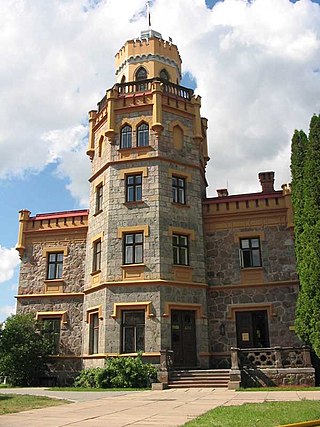
Sigulda Castle also known as Sigulda New Castle. Built in 1878 in the Neo-Gothic style as the living house for the owners of the manor, the Kropotkin family. The building has changed its owners and functions several times. Since 1993, the Sigulda Region Council has been located in the castle.

Koknese Castle is a complex in Koknese, Latvia, dating from the 13th century. The castle was situated on a high bluff overlooking the Daugava river valley. In 1965 a hydroelectric dam was built downriver, creating a reservoir that partially submerged the castle and flooded the surrounding valley.

Aizkraukle Municipality is a municipality in Vidzeme, Latvia. The municipality was formed in 2001 by merging town Aizkraukle and Aizkraukle Parish the administrative centre being Aizkraukle. The population in 2020 was 8,024.
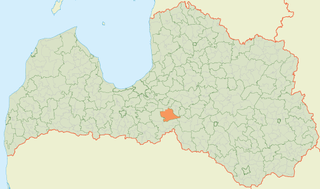
Birzgale Parish is an administrative territorial entity of the Ogre Municipality, Latvia. The entire parish is on the left bank of the Daugava, in the region of Semigallia. The parish borders with Tome Parish, Vecumnieki Municipality Vecumnieki Parish and Valle Parish, Jaunjelgava Municipality Jaunjelgava, its rural territory and Sērene Parish, along Daugava with Skrīveri Municipality, Lielvārde Municipality Lielvārde city, its rural territory and Jumprava Parish.

Stukmaņi Manor is a manor house in Klintaine Parish, Aizkraukle Municipality in the Vidzeme region of Latvia.

Odziena Manor is a manor house built in Neo-Gothic style around 1860 in Vietalva Parish, Aizkraukle Municipality in the Vidzeme region of Latvia.

Aizpute Castle is a Livonian Order castle in the town of Aizpute in the historical region of Courland, in western Latvia. It was heavily damaged during the Second Northern War (1655–1660). Since 1998, the castle ruins are a Latvian historical monument.

Lielvārde Castle is a castle in Lielvārde, a town in Ogre Municipality in the Vidzeme region of Latvia.The castle was built at the steep bank of Daugava River, overseeing this important medieval waterway, before 1248 by Albert of Buxthoeven, an archbishop of Riga. During the Livonian War, Lielvārde Castle was destroyed by Russian troops in 1579. Its ruins are conserved up to the level of the second floor.

Ludza Castle was a medieval castle built in Gothic style located next to a Catholic church, on the site of a former Latgalian wooden castle in the centre Ludza, Latvia, a small town in eastern Latgale. Its main purpose was to be an eastern outpost to control trade routes from Russia. Nowadays the impressive fragments of the castle walls, including a three-floor high fragment, still remain. The ruins are the main tourist attraction in the Ludza District, and is considered a symbol of the town.
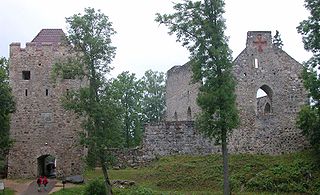
Sigulda Medieval Castle ruins are located on the edge of the Gauja valley in Latvia. The original castle was built in 1207 as a castellum type fortress, later rebuilt into a convent type building. The residence of the Land Marshal of the Livonian Order since 1432.
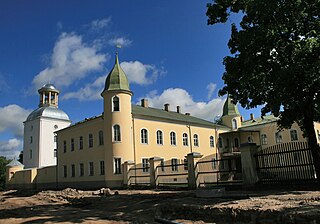
Krustpils Castle is a castle in Jēkabpils, Latvia. It is one of the best preserved medieval castles in Latvia. During the Russo-Turkish War (1877–1878), Turkish prisoners of war were held here, many of whom later settled here permanently. Here the Latgale artillery regiment was located. During the Second World War infirmary of the German army was located here. A military hospital of the Red Army was placed here after August 1944.

Dundaga Castle is a medieval castle in Dundaga, in the Talsi Municipality in the Courland region of Latvia. Latvia considers Dundaga Castle to be a monument of archaeological and of architectural importance.

Rauna Castle ruins are located in the village of Rauna in Rauna Parish, Smiltene Municipality, in the Vidzeme region of Latvia. The castle was the principal residence of the Archbishopric of Riga, and was visited each year by the Archbishop and his entourage. During the 16th century, it was greatly expanded and a settlement developed around the castle. It was first demolished in the 17th century, but the towers and parts of the castle still remain.

Valmiera Castle was a castle in Valmiera, Latvia. Today its ruins lie in the city centre.





















